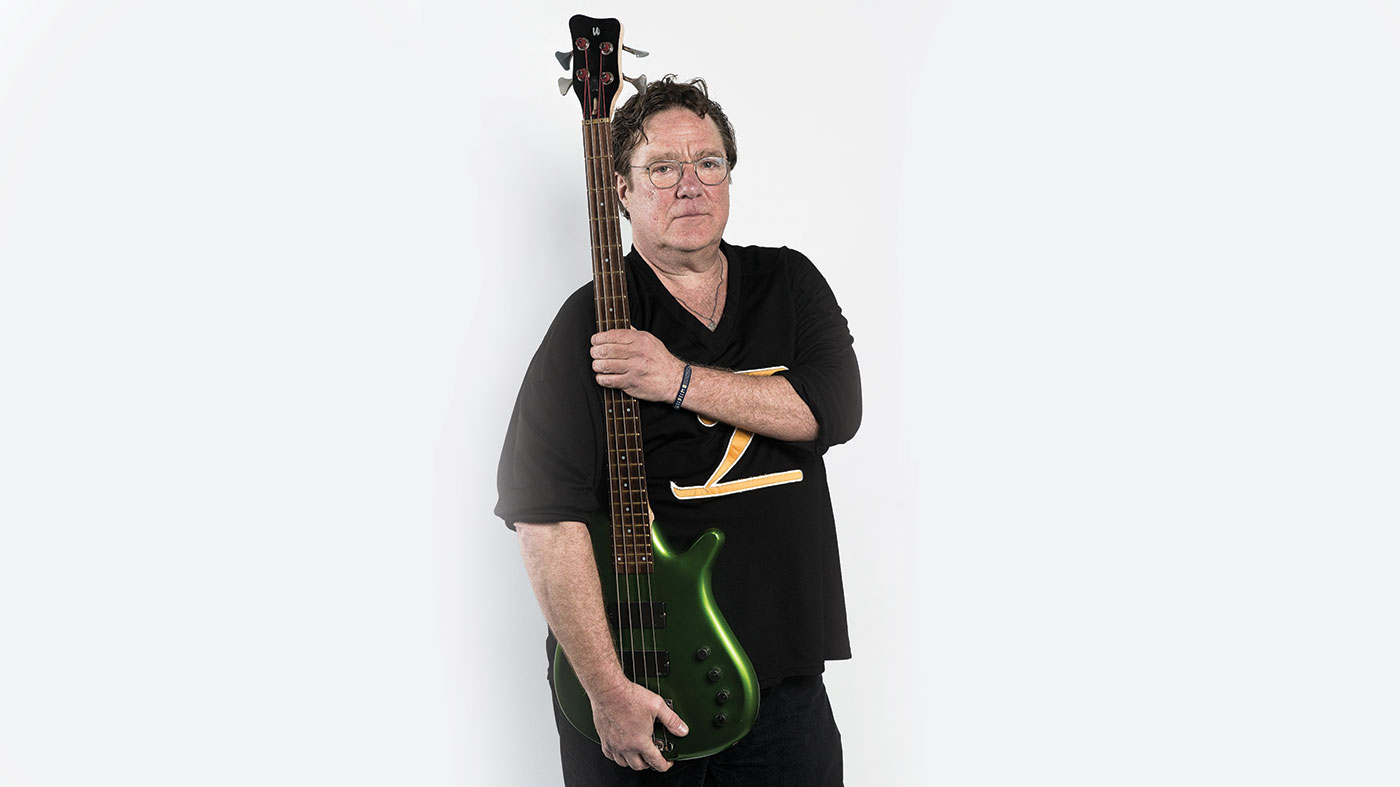Stu Hamm: “Tuning is a myth; it’s like money in that it’s a shared hallucination”
The bass maestro on tuning, tone and The Diary Of Patrick Xavier

Stu Hamm is a force of nature in the world of bass, bringing supernaturally evolved techniques and a fully evolved gear obsession to conceptual songwriting skills. The great man goes deep with his new album, The Diary Of Patrick Xavier.
Many musicians experience a loss of creative drive, allied to a lack of enthusiasm for life on the road, after three or four decades of applying fingers to strings. Not Stuart Hamm, the veteran session and stage bassist, solo recording and touring artist and virtuoso.
It’s 30 years since the American legend entered the public eye on albums and tours with Steve Vai, Joe Satriani, Frank Gambale and many other artists of note, and his eighth solo album, The Diary Of Patrick Xavier, is out now.
Every song on this album has a theme - they aren’t just about grooves or licks
The album, based on the titular journal - discovered by Hamm in a hotel room while on tour - is a spectacular piece of work, in keeping with his previous catalogue.
It’s not simply a display of techniques, however, although there’s plenty of supremely accomplished bass-playing to enjoy; Hamm has also infused the songs with the spirit of exploration and joy of new experiences with which Patrick (a pseudonym) filled his diary. He explains these concepts in detail in the CD booklet, a perfect reason - if one were needed - to purchase the physical artefact rather than just a download.
“You know, every song on this album has a theme - they aren’t just about grooves or licks - so the stories needed to be published in the right way so people could read them,” says Hamm down the line from California.
“I thought I’d put the cart before the horse and explain how I went about the music and the emotions in the songs. I’m super-pleased with the way it came out.”
Get the MusicRadar Newsletter
Want all the hottest music and gear news, reviews, deals, features and more, direct to your inbox? Sign up here.
Buy one and the proceeds go straight into Hamm’s pocket, thanks to its crowdfunded status.
“It’s not like someone was standing in the wings with $20,000 to give me to produce this semi-serious piece of art,” he chuckles. “So I set up an Indiegogo campaign and it really helped, because it enabled me to hire a decent graphic artist and to do a really nice booklet.”
Complete control
Hamm is quick to point out that although there’s an intellectual background to the songwriting, the listener is perfectly able to bypass those parts and simply enjoy it as a piece of musicianship.
“It’s designed to operate on a couple of different levels,” he explains. “You could just put this record on as music for the background, because it’s calm and comforting and mellow and pleasing for 50 minutes, or you can get really deeply into it and figure out what I’m doing.”
It’s about control of the instrument, and I was in a nice place in that respect when I was recording the album
And what is that, exactly?
“Well,” he ponders, “I’m getting better as a player, I think, but I think I’m getting better at writing songs too. I want to create a mood, whether it’s by letting certain notes ring and other ones die, and being aware of how the notes fade out, and where the ends of the notes come. Probably no-one notices, but there are some things along those lines that I’m super-proud of. It’s not about soloing over Giant Steps at 240 bpm; it’s about control of the instrument, and I was in a nice place in that respect when I was recording the album.”
Bass-only albums come in various flavours, from effects-drenched experiments to those which focus on the instruments’ natural tone. The Diary Of Patrick Xavier is firmly one of the latter, based mostly on the unaffected tone of Hamm’s Warwick and a simple signal chain.
“Every time we go to record the bass, we do a DI, a close mic and a room mic,” he says. “Me and my engineer do a mix - and 99 percent of the time, it comes down to using the DI alone. We get rid of the room sound completely.”
Still, there’s the occasional stompbox about, he adds.
“The more experimental songs like Co. Rd and The Ballad Of Billy Pilgrim were a departure for me, because my big thing has always been to create different sounds on the bass without using effects. This time, I deliberately used effects to create a mood on those songs, especially Ballad. It’s essentially a load of volume swells, which to me make it one of the most powerful pieces on the record.”
Out of tune
On the final song, Hello, Hamm tells the listener ‘Ask me about the tuning.’ Well, Stu? He laughs; this is evidently a subject close to his heart.
“Tuning is a myth; it’s like money in that it’s a shared hallucination. You know when you hear Portrait Of Tracy and Jaco hits that minor seventh - the F on the G string - you think ‘God, that’s out of tune’? Well no, it’s not out of tune; why would something that occurs naturally in nature be out of tune?
“Whoever decided what temperament is, and how to get a piano in tune, has trained our ears to hear certain intervals - even though, when you hear the third on a fretted instrument, it’s actually an eighth of a pitch off! It’s horribly sharp, and for me, a sharp bass creates tension.”
Whoever decided what temperament is, and how to get a piano in tune, has trained our ears to hear certain intervals
He adds: “The Swedish company True Temperament and other people have done many things to address this. The first time you play chordally on True Temperament frets, which are curved, you think it sounds weird and wrong, because you’ve never actually heard a fretted instrument be in tune before. Once you get used to it, the physical resonance makes them feel as though they’re really in tune. It’s so calming.”
So why not switch to a bass equipped with True Temperament frets on a full-time basis, we ask?
“Unfortunately, you can’t play with anybody else, because you can’t bring a True Temperament bass to a session. If you do, you’ll be out of tune with every other musician!” he laughs.
“And those frets take a lot of getting used to when it comes to tapping and chords… I feel the same about the fanned-fret system; I can’t imagine how you could play chords on those things.”
As Hamm followers will know, he’s a string obsessive, changing his GHS Boomers for every single gig and even in mid-performance.
“I used my last set of black nylon Boomers on this album,” he says. “They don’t make them any more, so I’ve been saving them.”
He’s also keen to make bass guitar technology more efficient, and recounts a recent experiment over at Warwick’s facility in south-eastern Germany.
“Marcus [Spangler, Warwick/Framus head of production] and I tried some pretty crazy things over at the factory,” he says.
“We had this idea for a bridge, and we thought, ‘Why’s no-one ever done this? We’re gonna be millionaires!’ but then we realised that the reason no-one had ever done it was because it was a stupid idea that didn’t work, haha! It was awful, but we gave it a try...”
Go-to gear
He continues: “My old Fender Urge basses were strung through the body, which means that the string comes up and immediately does a very sharp angle over the bridge saddles. I loved that because it gives so much tension to the strings, which was great for tapping, as well as making the tone really bright.
“Later, I switched to basses with a longer distance between the bridge and the nut, and there was so much less tension, so our great idea was to put the string through the body and then have them go backwards - around the butt of the bass - before going to the bridge. But it didn’t work; you’d need strings that are stupid long, plus you’d ruin the integrity of the body wood by drilling extra holes in it.”
My main Warwick is the third prototype that they’ve made for me. It has a green Streamer body, a neck that Marcus built for me that is amazing, and EMG pickups
Instead, Hamm’s gear remains tried, tested and familiar. “My main Warwick is the third prototype that they’ve made for me. It has a green Streamer body - it used to have a ‘Banner’ sticker on it, because it’s the same colour as the Hulk. It has a neck that Marcus built for me that is amazing, and EMG pickups, which always sound incredible to me. I also use my old Fenders and Washburns from time to time, and I use Markbass amps with a 2x15 cab, and of course the GHS Boomers strings. That’s it, man; simple!”
Gear is crucial, of course, and so is technique, but songwriting is key to any solo musician’s art. How does Hamm come up with songs?
“I have different approaches, because I’m always practising and coming up with new ideas,” he says. “Maybe a technique or an experiment will become a chord progression or a groove, and then, once I come up with a title and I know what it’s going to be about, I fill in the blanks from there. In one of the new songs, The City, I wrote a song using just one melody, because I’m a huge fan of the soundtrack composer Bernard Herrmann, who often wrote single lines that outlined chords.”
So when are we going to meet Mr Xavier in person? Not any time soon, he tells us…
“Obviously I’ve changed the names to protect the innocent. I gave him the name ‘Patrick’ because it links to ‘ex-pat’, which is what he is, as a world traveller. No, I haven’t tried to track the guy down. I guess I’ll leave the poor man alone!”
The Diary Of Patrick Xavier is out now


“I’m beyond excited to introduce the next evolution of the MT15”: PRS announces refresh of tube amp lineup with the all-new Archon Classic and a high-gain power-up for the Mark Tremonti lunchbox head
“These guitars travel around the world and they need to be road ready”: Jackson gives Misha Mansoor’s Juggernaut a new lick of paint, an ebony fingerboard and upgrades to stainless steel frets in signature model refresh









